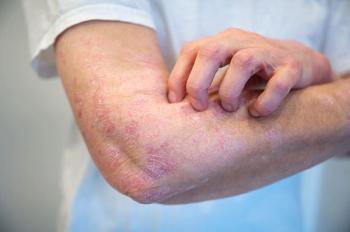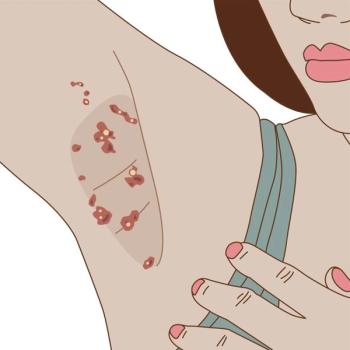
A painful, red, swollen ear; recurrent vesicles on 1 hand; a pururitic truncal eruption
For 1 week, a 35-year-old woman’s left ear has been very painful, erythematous,and swollen. There is no history of insect bite or trauma. Her conditionimproved only slightly after the physician she initially consulted prescribedmethylprednisolone and cephalexin.
Case 1: For 1 week, a 35-year-old woman’s left ear has been very painful, erythematous, and swollen. There is no history of insect bite or trauma. Her condition improved only slightly after the physician she initially consulted prescribed methylprednisolone and cephalexin. What do you suspect?
A. Bacterial cellulitis.
B. Fungal cellulitis.
C. Relapsing polychondritis.
D. Insect bite reaction.
E. Chondrodermatitis nodularis chronica helicis.
Case 1: The patient has relapsing polychondritis, C, a diagnosis that is difficult to make without a biopsy. This condition is characterized by intermittent episodes of inflammation of cartilage that contains type II collagen, such as is found in the ears, trachea, and nose. Onset is typically in the fourth or fifth decade. Bacterial cellulitis usually responds to cephalexin, and fungal cellulitis is uncommon in healthy persons. Chondrodermatitis nodularis chronica helicis is a painful papule found on the helical rim; it affects primarily middle-aged men.Case 2: A 24-year-old woman seeks evaluation of a pruritic eruption of 2 weeks’ duration on her trunk and proximal extremities. The eruption consists of numerous small red spots (A and B) and a smaller number of larger, more erythematous lesions (C and D). The patient takes an oral contraceptive and is in good health. What condition(s) are you looking at here?
A. Psoriasis.
B. Pityriasis rosea.
C. Urticaria.
D. Urticarial vasculitis.
E. Mycosis fungoides.
F. Pityriasis lichenoides chronica.
Case 2: The appearance and distribution of the small, oval, salmon-colored macules on the patient’s trunk point to the diagnosis of pityriasis rosea, B. A tapering course of prednisone was prescribed for this patient. The smaller lesions resolved promptly, but the larger ones remained and were extremely pruritic. A biopsy revealed urticarial vasculitis, D, a hypersensitivity response that appears as an exaggerated urticarial reaction that can last for months. The lesions respond to dapsone therapy. The cause of urticarial vasculitis is usually unknown; however, in this patient, it may have been related to the pityriasis rosea. Psoriasis is characterized by scaling. Urticaria tends to appear and subside; individual lesions usually last 24 hours or less. Mycosis fungoides and pityriasis lichenoides chronica are typically not highly pruritic; these conditions can be ruled out by biopsy.
Case 3: A 44-year-old man complains of a pruritic groin rash of 5 months’ duration. Application of betamethasone-clotrimazole cream for 3 weeks and a 3-month course of oral terbinafine failed to resolve the rash. The patient is otherwise healthy and currently takes no medications. Do you recognize this rash?
A. Tinea cruris.
B. Candidiasis.
C. Intertrigo.
D. Contact dermatitis.
E. Erythrasma.
What action would you take?
F. Prescribe an oral imidazole antifungal.
G. Advise the patient to use a different laundry detergent and fabric softener.
H. Prescribe a topical imidazole or ciclopirox.
I. Advise the patient to apply a drying agent, such as talcum powder or aluminum acetate solution.
J. Prescribe a topical antibacterial agent, such as clindamycin.
Case 3: A potassium hydroxide evaluation confirmed the diagnosis of candidiasis, B. The betamethasoneclotrimazole combination has a significant failure rate against fungal infections, and oral terbinafine is not significantly active against cutaneous yeast organisms. Better choices are a topical imidazole or ciclopirox, H. Tinea cruris would have responded to the oral terbinafine. Contact dermatitis to elastic, detergents, or fabric softeners usually involves the areas where underwear is the tightest. Intertrigo and erythrasma are diagnoses of exclusion; erythrasma does not respond to antifungal therapy.Case 4: For 9 months, a 42-year-old man has had an itchy rash on one hand that features small vesicles on the edges of the fingers and on the palm. Results of an initial potassium hydroxide (KOH) evaluation are negative. The rash responded temporarily to topical corticosteroid creams but then recurred. What is the likely cause?
A. Dyshidrosis.
B. Atopic dermatitis.
C. Contact dermatitis.
D. Dermatophyte infection.
E. Psoriasis.
Case 4: A second KOH evaluation reveals a dyshidrosiform reaction to a dermatophyte infection, D. Generally, unilateral involvement suggests a fungal infection. Persons with atopy usually have a history of seasonal allergies or sensitive skin. The positive results of the second KOH evaluation ruled out contact dermatitis. Psoriasis is bilateral (unless there is a Koebner reaction) and involves nail pitting.
Newsletter
Enhance your clinical practice with the Patient Care newsletter, offering the latest evidence-based guidelines, diagnostic insights, and treatment strategies for primary care physicians.


